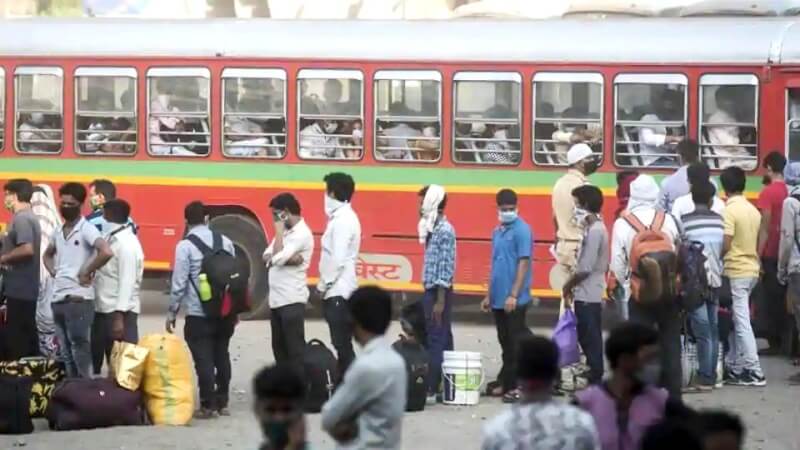
On Monday (18 May 2020) night, Maharashtra Chief Minister Uddhav Thackeray addressed the state on social media – a much-anticipated speech on the possible easing of lockdown restrictions in the state.
That wasn’t to be.
Instead, he said, his government will continue to with red zone restrictions in the state and will not ease the lockdown until at least 31 May 2020.
The reason?
The rising number of COVID-19 cases in Maharashtra, and feedback that told him things would have been even worse, possibly “alarming” without the lockdown.
Soon after his speech, the State Health Department released the daily COVID-19 numbers for Maharashtra. In the previous 24 hours, the state had added 2,033 new cases, taking the total positives to 35,058. At the same time, authorities recorded 51 deaths.
Maharashtra now has 1,249 deaths. This meant that Maharashtra has more than three times the number of cases recorded by Tamil Nadu (11,760), Gujarat (11,746), and Delhi (10,554) – the three states immediately below it in the COVID-19 affected list. Simultaneously, Maharashtra accounts for 39.41% of all COVID-19 fatalities in India (Mumbai’s share in this grim statistic is 23.89%).
There are more sobering numbers from Maharashtra: It recorded 20,607 coronavirus cases in the last 14 days (05-18 May), averaging 1,471 new cases per day. Mumbai recorded 12,025 cases at the same time, averaging 859 per day. Earlier this week, both Maharashtra and Mumbai reported record one-day spikes (2,347 and 1,595 cases respectively on 17 May).
To be sure, a similar trend was observed throughout India during this period; 54% of the country’s 102,287 cases (6 PM, 19 May) have been recorded in the last two weeks.
State Health Minister Rajesh Tope indicated earlier this week that the worst is yet to come. “We expect the cases to peak by the end of June,” he said. But some experts differ, saying that it may come down after 14 days (31 May) when the fifth incubation period of the virus will be over.
Dr. Tatyarao Lahane, Director, Directorate of Medical Education and Research (DMER) said on Tuesday, “We will have to wait for another 14-day incubation cycle to complete (by 31 May). After this, the rise is likely to come under control, and we may witness a gradual decline. If it does not reduce then, we may be in the community transmission stage.”
He added that the state has not reached the community transmission stage as there is no exponential growth in the number of fresh cases. For comparison, Maharashtra recorded 24,588 cases in the first 18 days of May, whereas it recorded 10,201 cases in April. It took the state 30 days to reach 1,000 cases, but only 23 more for 10,000.
The numbers, while on a rising trajectory, have not resulted in a high death rate. On 12 April, Maharashtra and Mumbai recorded the highest mortality rate of the pandemic – 7.52% and 7.09% respectively. On 18 May, this dropped to 3.56% and 3.55%. India’s overall mortality rate is 3.1%.
Maharashtra’s testing rate has also risen dramatically in a month. On 14 April, the state was testing at an average of 290 per million population. However, on 19 May, according to Maharashtra Medical Education and Drugs Department data, the testing rate had risen to 2,409 per million. Tamil Nadu is testing at 4,463 per million, according to the state’s health department.
Dr. Satyajit Rath, retired scientist from the Delhi-based National Institute of Immunology and adjunct faculty at the Indian Institute of Science Education and Research, Pune, said, “It is always good to test more. But the fact remains that the crucial time to be testing extensively was in the early stages of the epidemic when outbreak control was much more feasible. Now, we have established local transmission. While it remains very important to test a lot, increasing overall testing numbers by itself may not have a big effect on slowing down transmission rates in local events.”
Another scientist, Abhay Chowdhary, agrees. Dr. Chowdhary is the Head of the Department of Microbiology at Navi Mumbai-based DY Patil University and Former Director of Haffkine Institute for Training, Research, and Testing. “Even though the state is running more tests, individuals are violating physical distancing rules, for instance, in containment zones. As a result, those infected get mixed with the healthy population,” said Chowdhary on Tuesday. “This is more worrisome in the case of those who are suffering from existing ailments. Even if 1-2% of individuals have co-morbid conditions, it will put an immense strain on the state’s health care infrastructure.”
The state government said last week that it has resolved to make the entire state a green zone by the end of the month (currently there are 18 red zone districts). This seems unlikely as, according to the Health Minister Rajesh Tope, “all the predictions about Mumbai and Maharashtra have not come true. The numbers are rising and we feel that the peak is yet to come. According to our mathematical models, the number of cases in Mumbai will likely be four times the current figure by the end of June. We are trying to prevent it, but have to be prepared for the worst and hope for the best.”
Dr. Rath says one of the hurdles to get more testing is the scarcity of labs. But that the biggest failure may have been the underfunding of our health care system. “We have underfunded our public health system and starved it of resources for a long time; a problem that we cannot now fix overnight. I can only hope that we do not forget this mistake once the pandemic passes.”